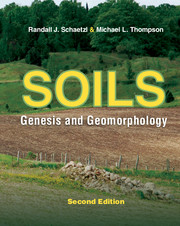6 - Basic Concepts: Soil Physics
Published online by Cambridge University Press: 12 January 2024
Summary
Soil physics is the branch of soil science that deals with the physical properties and processes of soils. Soil physics is generally concerned with the state and movement of matter and energy in soils; hence, most soil physicists study the movement of water in soils, and the changes in soil temperature, over time and space. Soil physical properties such as water content, texture, and structure, as well as soil physical processes such as water retention and transport, soil temperature and heat flow, and the composition of the soil atmosphere (mainly O2 and CO2), all affect weathering and soil genesis. Therefore, in this chapter we discuss the basic concepts of soil physics that are necessary as background to the discussions of soil genesis and geomorphology in more depth that follow.
Soil Water Retention and Energy
Many pedogenic processes begin and end with the flow of water in soils (see Chapters 13 and 14). Water is the main agent by which solids and ions are transported within soils. Knowledge of the forces acting on water flow is, therefore, important for understanding soil genesis, not to mention soil use and management.
Water is retained in soils in two ways. Adsorbed water molecules are retained at or very close to the surfaces of soil particles. They are held there by attractive forces acting between the water molecules and the surface, or between water molecules and ions near the particle surface. Water that is absorbed is taken into the pores of a solid (soil, mineral, rock particle, or organic substance) and is retained by the surface tension of the water molecules interacting with one another in small pores. Water retention in soils, in both adsorbed and absorbed forms, increases with increasing contents of clay and organic matter because of the affinity of those solids for water.
Liquid water has high surface tension because the H atoms in each H2O molecule form strong hydrogen bonds to the O atoms of neighboring water molecules. The polar, hydrogen-bonding nature of water also leads to a strong, adhesive attraction between water molecules and most soil particles. For example, water molecules can form H-bonds with OH groups on oxide minerals and at the edges of clay minerals, as well as with NH and OH groups on soil organic matter. In addition, water molecules strongly solvate cations that are adsorbed by soil minerals.
- Type
- Chapter
- Information
- SoilsGenesis and Geomorphology, pp. 85 - 94Publisher: Cambridge University PressPrint publication year: 2015



